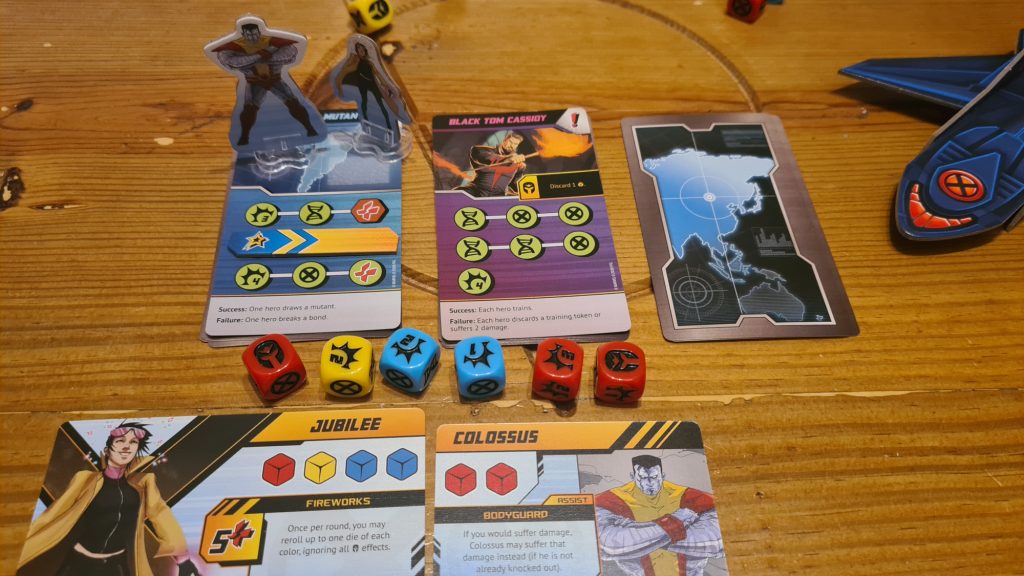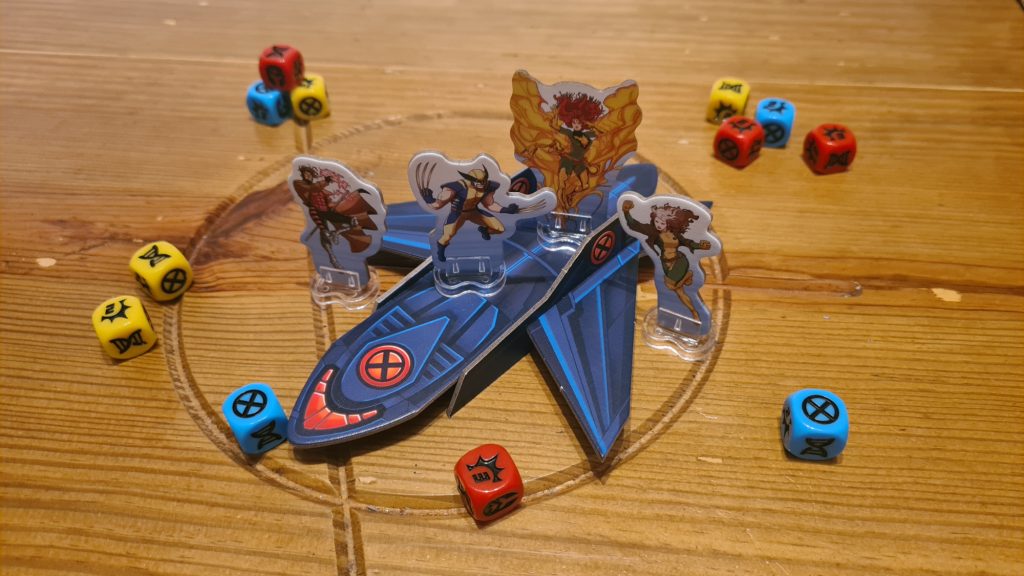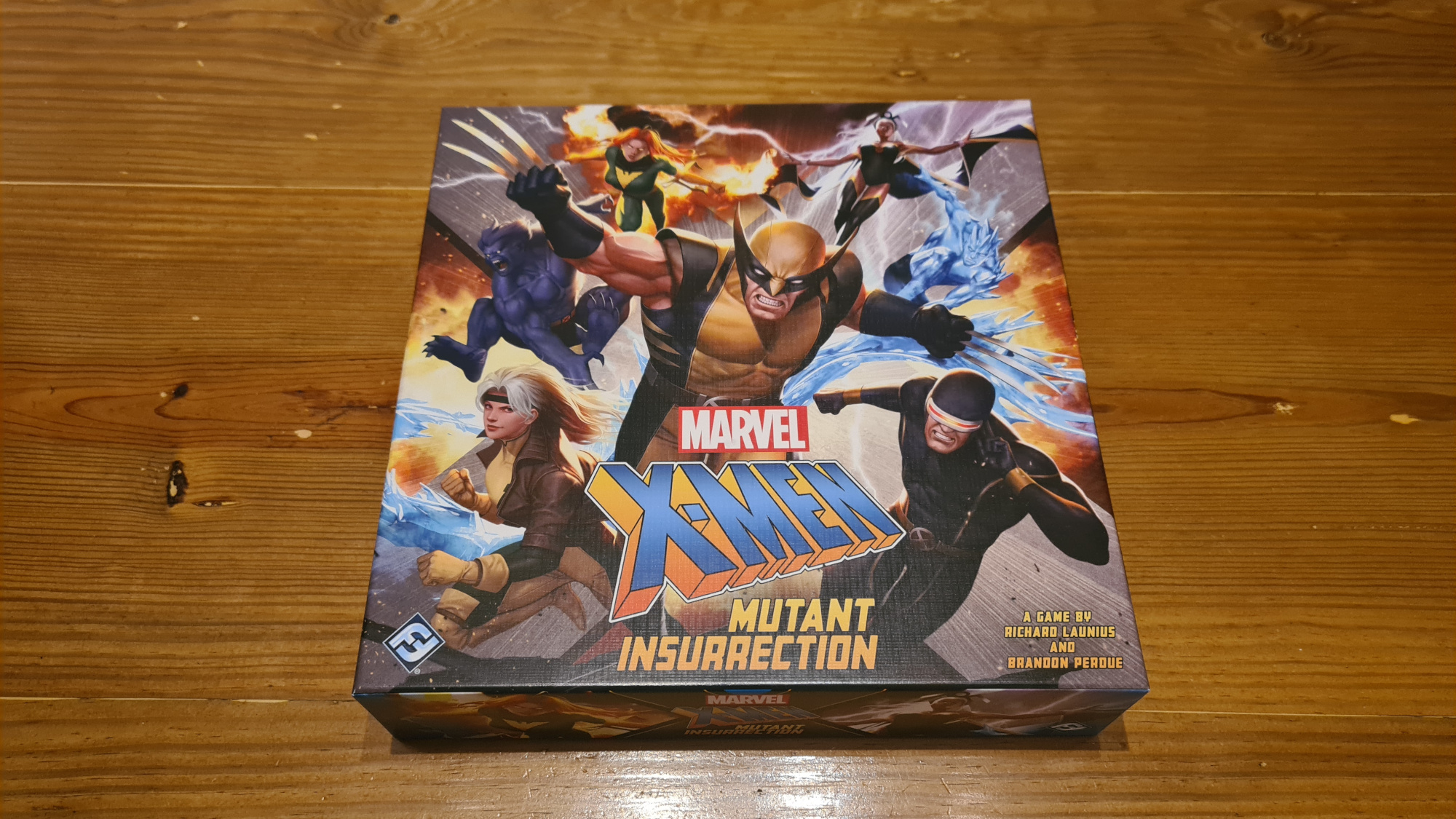X-Men Mutant Insurrection is the brand new cooperative, dice based, board game from publisher Fantasy Flight Games. Designed by Richard Launius and Brandon Perdue, the game sees 1 – 6 players spend around an hour controlling their favourite X-Men heroes. Using dice, training, bonds and abilities the X-Men must overcome a range of missions, with the team starting each time on the Blackbird. However, is this like an adventure straight from the comics or films? Let’s find out!
The game begins with players choosing which of the 16 X-Men heroes to play. They claim the hero’s power card and the assist card, and place the standee onto the Blackbird. Choosing a plot, players shuffle the threat decks and the continent mission decks, place the threat maker onto the tracker at the groups chosen difficulty, and any special plot related cards are put into play. Players will be working cooperatively to take on missions, objectives, sentinels and more, leading towards the final showdown.
Played out in phases the rounds start by deploying to locations. Locations can be mission cards or school locations – which are predominately to regain health. Moving onto the mission phase all heros on mission cards prepare to fight. Deciding who will go first between the players, the active player starts by attempting the objectives on the card they deployed to, revealing the mission card if it was face down. If two or more heroes have gone to the same mission, each hero can be assisted by one other by giving them their assist card.
The active hero then rolls the dice shown on their hero’s power card and, if they have one from another player, on the assist card too. Depicting fight, power, teamwork and villainy symbols the dice results are spent to fulfill objectives on the mission cards. For example, an objective may need a total of 2 power and 4 fight to be completed. The player could spend 2 dice featuring power symbols and a combination of dice that have a fight strength of 4 or higher to complete the objective. To help players do this they can re-roll dice twice, though rolled villainy symbols often have a cost to re-roll them – based on the mission this could be damage or discarding other dice.

Completed objectives are covered by success tokens, with all objectives of a mission needing to be completed before the end of the round. All players take their turns attempting the missions they are on. Successfully completed missions grant the players rewards, these can be training tokens (spent instead of dice on future missions), bonds between players and more. These generally make the players’ future turns that bit easier. If a mission isn’t fully completed then it is a failure and this can cause damage to heroes, break bonds or raise the threat level.
The game then fights back with the threat phase. Firstly, the threat level is increased by the number of ! icons on the cards still in play. Depending on the player count a number of new mission cards are then revealed for players to face. Based on the current threat level the players then draw a threat card. These can be sentinels that are added to missions to make them more difficult or events, which also are not good news for the players. The team then regroups back at the Blackbird, to start a new round with the deploy phase.
Each plot in X-Men Mutant Insurrection works a little differently but generally sees players completing a number of the regular missions, before unique missions are added into the mix. Eventually, players will go into the showdown to win the game. For the majority of the game the aim is to get to this showdown and not let the threat tracker reach 15. Heroes can even be completely taken out before the showdown, with the player simply drawing a new hero. In this showdown stage though if a player takes too much damage they are eliminated. The only way to win is to successfully pass the missions on the showdown card(s), with the team winning or losing together.
Not being eliminated until the showdown phase helps the game progress, and doesn’t leave someone sidelined from the experience. For first time players not being eliminated allows you to risk damage and learn the way the game works. Chances are players will also have a hero killed too, with them able to play as a few of their favourite heroes throughout the game.
When playing it’s hard to get involved in the theme, even when playing as your favourite characters. Swiftly they, the locations and opponents fade away. What the game becomes are cards that offer dice pools and challenges to roll. This isn’t to say there aren’t some thematic elements. Phoenix cannot be used in the Dark Phoenix plot, Wolverine’s assist card is to train for a fight and Shadowcat’s ability is to ignore damage requirements thanks to her ability of intangibility. Alas, they are easily forgotten when you get into the game.

With assists and bonds there is a bigger feeling of playing as a team, and it is important to do so. Getting those additional dice from the assist cards makes missions much more achievable and then there are the assist abilities that come with them. Having more players allows for more of these cooperative moments to occur and without them, at 2 players or solo, the game feels a little stale.
Like X-Men Mutant Insurrection’s predecessor Elder Sign, the game heavily revolves around dice rolls. Winning or losing the game, or even just individual missions, will be too reliant on luck for some but it allows the core of the game to be fairly easy to pick up. Plus, players have abilities and training tokens to mitigate some of the luck. The punishment of re-rolling the villainy symbols makes for some nice choices, though often players will know ahead of time if they are going to have to re-roll no matter what – else face a failed mission.
It’s nice to see that Fantasy Flight decided to go for standees instead of miniatures for the playable X-men heroes. This has afforded them the ability to include a huge range of characters from everyone’s favourite Wolverine through to mine Gambit, with many in between. Whilst miniatures are often epic, the roster included would certainly have had to shrink to hit the same price point and the standees feature the lovely artwork seen across all of the components. Other components stand out, with the training tokens being great physical reminders to use them when rolling for missions. The only tokens that slightly let the game down are the damage tokens, being a little small and fiddly, though even these aren’t inherently bad.
X-Men Mutant Insurrection has taken the core gameplay of Elder Sign and made a range of tweaks and improvements. Players could just about assist one another in Elder Sign but in X-Men Mutant Insurrection it’s much more important and beneficial to assist your teammates. Gone is the dark, grimy Cthulhu theme and replacing it is a colourful comic book presentation – and one that will probably appeal to a wider audience. While there might not be a huge pull to return and replay a plot over and over, X-Men fans have multiple plots to playthrough and plenty of heroes to utilize. If you can overlook the luck of the dice then this could be the superhero cooperative experience for you.
(Editor’s Note: X-Men Mutant Insurrection was provided to us by Asmodee for the review. The game is currently available from local board game stores! Find your local store here.)

